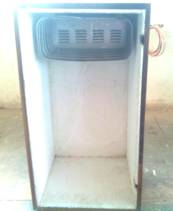





Published on Nov 30, 2023
This work investigates the result of an experimental study carried out to determine the performance of domestic refrigerator when a propane-butane mixture is liquefied petroleum gas (LPG) which is locally available and comprises 24.4% propane, 56.4% butane and 17.2% isobutene which is very from company to company. The LPG is cheaper and possesses an environmental friendly nature with no ozone depletion potential (ODP).
It is used in world for cooking purposes. The various methods of refrigeration on the basis of standard refrigerant discussed. He refrigerator used in the present study is of medium size with a gross capacity of 125 litre and is designed to work on LPG.
The performance parameters investigated is the refrigeration effect in certain time. The refrigerator worked efficiently when LPG was used as refrigerant instead of CFC 12. The evaporator temperature reached -5 ºC with and an ambient temperature of 12 ºC.
Also from the experiment which done in atmospheric condition, we can predict the optimum value of cooling effect with the suitable operating condition of regulating valve and capillary tube of the system. The results of the present work indicate the successful use of this propane-butane mixture as an alternative refrigerant to CFC 12 in domestic refrigerant.
CFC's are principally destroyed by ultraviolet radiations in the stratosphere; the chlorine released in the high stratosphere catalyzes the decomposition of ozone to oxygen; and ultraviolet radiations penetrates to lower altitudes. Credible calculations of the magnitude of the effect (Hoffman 1987) and his team predicted 3% global ozone emissions of 700 thousand tonnes/year after a hundred years.
The ozone impact of car air conditioners also can not be ignored. Hydrofluorocarbons (HFC's) can be thought of as a replacement, but unfortunately the radiation properties of HFC's like R-134a make them powerful global warming agents. HFC 134a and the HC blend have been reported to be substitutes for CFC 12, but they have their own drawbacks in energy efficiency, flammability and serviceability aspects of the systems. HFC 134a is not miscible with mineral oil, and hence, polyol ester oil is recommended, which is highly hygroscopic in nature. This hygroscopicity demands stringent service practices, which otherwise results in moisture entry into the system.
Thus, hydrocarbon refrigerants; particularly LPG serves as the best contender to replace CFC's from domestic refrigerator as well as car air conditioners.
The LPG refrigerator shown in figure. We make the one box of the plywood. The plywood sheet size is 12mm for used the LPG refrigerator. The size of the refrigerator is 724*457*381 mm3. The evaporator is fitted on the upper portion of box inside.
Inside the refrigerator, we also put the thermo-coal sheet, because of the cold air can not the transfer from inside to outside of refrigerator.

Fig 3.1 :- Construction of the LPG refrigerator
The schematically diagram of the LPG refrigeration system is shown in next page. The gas tank is connect by pipes to the capillary tube. The capillary tube is fitted with evaporator. The evaporator coiled end is connect to the stove by another gas circulation pipe. When two pressure gauge is put between capillary tube and gas tank, and another is put the end of the evaporator.